|
Posted 12/13/22
ON THE ONE HAND…BUT ON THE OTHER…
California’s lethal force laws devolve into a legal Neverland
For Police issues by Julius (Jay) Wachtel. A few days ago the City of Pomona, Calif. and its police department settled a long-running ACLU lawsuit (Gente Organizada v. Pomona, L.A. Superior Court case no. 20STCV28895). While no bucks will apparently change hands, the agreement seemingly imposes significant restraints on the city’s cops.
Among (many) other things, Pomona P.D. must revamp its use-of-force rules to conform with the August 2019 revision of California Penal Code Sec. 835a. Officers will have to be informed that the decision-making process about using deadly force has become far more demanding, creating “a higher standard for the application of deadly force in California.” They must also receive extensive training to assure that the “new normal” is incorporated into everyday practice.
We’ll get into the specifics of Pomona’s travails later. But first, let’s examine the disturbing episode that propelled the change in California’s police use-of-force laws. We posted a detailed essay (“A Reason? Or Just an Excuse?”) about the fraught event two weeks after it took place. It didn’t happen in Pomona but in the State’s capital, Sacramento. To summarize, on March 18, 2018 city police officers encountered Stephon Clark, 22 as they responded to a late-evening 9-1-1 call about someone “going into back yards and breaking the windows of parked cars.” Clark was quickly spotted by a helicopter. His behavior fit the suspect’s, and as he ran from officers and entered yet another rear yard the threat level skyrocketed.

Clark took refuge under a patio. (Click here for helicopter video and here for officer bodycam video). Two officers peered around a wall. And as Clark (that third, lone figure) motioned with one of his hands, which held an indistinct object, they opened fire. After all, it simply had to be a gun. Alas, what they couldn’t predict was our essay’s subtitle: “Figuring out why officers kill persons ‘armed’ with a cell phone”. Neither did they know that this was the residence of Clark’s grandmother, with whom he was staying.
Click here for the complete collection of compliance and force essays
Clark, who was on probation for robbery, was clearly up to no good. His behavior had inarguably placed two cops in a tough spot. Apparently so tough that one year later, on March 2, 2019, the Sacramento D.A. announced that neither officer would be charged.
Based on the circumstances of this incident, Officers Mercadal and Robinet had an honest and reasonable belief that they were in imminent danger of death or great bodily injury. Therefore, they acted lawfully in shooting Clark to defend themselves. Accordingly, we will take no further action in this matter.
Three days later that decision was seconded by the California Attorney General. And on September 26, 2019, the U.S. Department of Justice determined that there was insufficient evidence to pursue Federal civil rights charges.
When Mr. Clark was shot dead two long-standing California statutes governed police use of force. Penal Code section 835a, which didn’t then specifically mention lethal force, bound cops who had probable cause to make an arrest to use “reasonable force to effect the arrest, prevent escape or overcome resistance.” In contrast, P.C. section 196 was all about lethal force. It deemed it justifiable:
1. In obedience to any judgment of a competent Court; or,
2. When necessarily committed in overcoming actual resistance to the execution of some legal process, or in the discharge of any other legal duty; or,
3. When necessarily committed in retaking felons who have been rescued or have escaped, or when necessarily committed in arresting persons charged with felony, and who are fleeing from justice or resisting such arrest. [emphases ours]
P.C. 196’s emphasis on “necessity” didn’t automatically endorse the shooting of Mr. Clark. But in 1989, the U.S. Supreme Court ruled in Graham v. Connor that the unforgiving nature of the police workplace must be taken into account:
The ‘reasonableness’ of a particular use of force must be judged from the perspective of a reasonable officer on the scene, and its calculus must embody an allowance for the fact that police officers are often forced to make split-second decisions about the amount of force necessary in a particular situation.
And as Sacramento D.A. Anne Marie Schubert reached the end of her sixty-one page decision, that’s where she turned. While Graham was a Federal Fourth-Amendment case, its grant of that “allowance” apparently inspired her to conclude that the cops couldn’t be faulted as they had done their “reasonable” best.
Needless to say, the reaction wasn’t all positive. Here, for example, is what the ACLU had to say:
Police departments in California are some of the deadliest in the country. Police in Kern County, for example, have killed more people per capita than in any other county in the U.S. But many of these deaths could have been prevented if police were held to a higher standard that valued the preservation of life.
 Mr. Clark was Black, so his killing carried racial implications. But it wasn’t all about race. After all, one of the cops who shot him was also Black. Still, it was left to Shirley Weber, a Black assembly member from the opposite end of the state, to lead the charge. She was soon joined by Kevin McCarty, a White assembly member from Sacramento. On February 23, 2017 they introduced AB 931, the "Police Accountability and Community Protection Act.” Its focus was Penal Code Section 835a. Here’s how the existing section then read, in full: Mr. Clark was Black, so his killing carried racial implications. But it wasn’t all about race. After all, one of the cops who shot him was also Black. Still, it was left to Shirley Weber, a Black assembly member from the opposite end of the state, to lead the charge. She was soon joined by Kevin McCarty, a White assembly member from Sacramento. On February 23, 2017 they introduced AB 931, the "Police Accountability and Community Protection Act.” Its focus was Penal Code Section 835a. Here’s how the existing section then read, in full:
Any peace officer who has reasonable cause to believe that the person to be arrested has committed a public offense may use reasonable force to effect the arrest, to prevent escape or to overcome resistance. A peace officer who makes or attempts to make an arrest need not retreat or desist from his efforts by reason of the resistance or threatened resistance of the person being arrested; nor shall such officer be deemed an aggressor or lose his right to self-defense by the use of reasonable force to effect the arrest or to prevent escape or to overcome resistance.
Despite its weighty topic, Section 835a’s word count was a stingy 99. Its suggested replacement, via AB 931 (click here), came in at an awe-inducing 858 words. Here’s an extract from its introductory content:
…a peace officer’s decision to use force must be evaluated from the perspective of a reasonable officer in the same situation, based on the totality of the circumstances known to or perceived by the officer at the time, rather than with the benefit of hindsight, and that the totality of the circumstances must account for occasions when officers may be forced to make quick judgments about using force in circumstances that are tense, uncertain, and rapidly evolving.
Well, that seems cop-friendly. But what followed imposed strict limits on the use of deadly force, and particularly against fleeing suspects. At the time, Penal Code Sec. 196 authorized police to use lethal force “when necessary” against known or suspected felons who flee or resist (see above). These provisions were eliminated. Lethal force was also broadly defined, encompassing “any use of force that creates a substantial risk of causing death or serious bodily injury, including, but not limited to, the discharge of a firearm” (emphasis ours.)
 AB 931’s complexities and unforgiving language drew strong objections from the law enforcement community. For example, the Peace Officers Research Association of California (PORAC) complained that while officers take “necessity” into account as a matter of course, making it an explicit standard might lead them to inappropriately hesitate: AB 931’s complexities and unforgiving language drew strong objections from the law enforcement community. For example, the Peace Officers Research Association of California (PORAC) complained that while officers take “necessity” into account as a matter of course, making it an explicit standard might lead them to inappropriately hesitate:
Hesitation will place our communities at greater risk as officers delay the response to a rapidly evolving and dangerous situation in order to review and evaluate a checklist of options before acting to protect the public safety.
Despite strong support from civil rights groups, as 2018 rolled to an end the bill quietly died. But in February 2019 Assemblymembers Weber and McCarty introduced a replacement measure, AB 392. Here’s the preamble to its new, supposedly improved version of P.C. section 835a:
(2) …it is the intent of the Legislature that peace officers use deadly force only when necessary in defense of human life. In determining whether deadly force is necessary, officers shall evaluate each situation in light of the particular circumstances of each case, and shall use other available resources and techniques if reasonably safe and feasible to an objectively reasonable officer.
At a full 833 words, the “California Act to Save Lives” is, like its abandoned predecessor, elaborately articulated. But constraints on police use of lethal force have somewhat relaxed from the bad, old AB 931. Here’s a side-by-side comparo of key text from both (emphases ours):
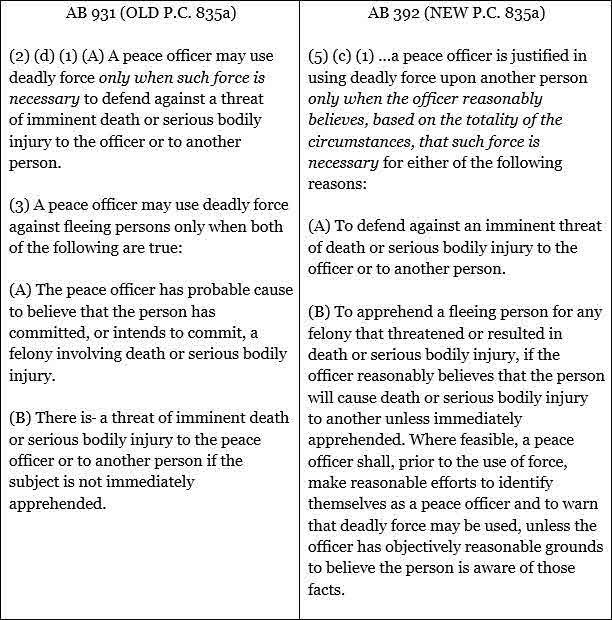
In the new version, the requirement that lethal force must in fact be “necessary” seems tempered. Ditto, constraints on using lethal force against fleeing suspects. AB 931 required that officers who wished to do so have probable cause that a suspect committed or intended serious violence. For AB 392, a prior act that “threatened” a bad outcome is enough. In actual practice, that could be a significant distinction.
 Still, considering the complexities that the “good, new” AB 392 introduces into P.C. 835a – again, we’re talking 833 words vs. 99 – many peace officer groups remained opposed. One complained that the new version “does nothing to change use of force policing policies, training, or guidelines-no funding for training, critical to any plan to reduce police use of force, and no proactive plan to achieve such a reduction in force.” But the highly influential (and politically attuned) California Police Chiefs Association shifted its stance from opposed to “neutral.” And on August 19, 2019, Calif. Governor Gavin Newsom signed AB 392 into law. Still, considering the complexities that the “good, new” AB 392 introduces into P.C. 835a – again, we’re talking 833 words vs. 99 – many peace officer groups remained opposed. One complained that the new version “does nothing to change use of force policing policies, training, or guidelines-no funding for training, critical to any plan to reduce police use of force, and no proactive plan to achieve such a reduction in force.” But the highly influential (and politically attuned) California Police Chiefs Association shifted its stance from opposed to “neutral.” And on August 19, 2019, Calif. Governor Gavin Newsom signed AB 392 into law.
Back to Pomona P.D. Why did it draw the ACLU’s ire? Go back to May 25, 2020. That’s the day when a Minneapolis cop squeezed the life out of George Floyd. And, not incidentally, forever altered the trajectory of American policing. Two months later, on July 31st., the ACLU sued. Filed in California Superior Court, the action claimed that Pomona P.D. “unlawfully used public funds and employee time in adopting policies and trainings — designed by police lobbying groups — that conflict with the new state law”. PORAC, the peace officer group that worried about hesitating cops, drew prominent mention:
The Pomona Police Department, in the spirit of that opposition, deleted in multiple spots the word “necessary” — the new law’s single most vital change — in its stated policy of state penal code. The department’s training center also instructed supervisors to review with employees PORAC’s content on AB 392 that denied any change to the legal standard for deadly force. A sergeant forwarded the directive with the note: “FYI from PORAC. Nothing has changed.”
In its announcement, the ACLU bitterly remarked that Pomona officers had “shot and killed three people since the law went into effect” on January 1st, 2020. That naturally raised the question of whether cops would have fired had Pomona sincerely attempted to train them about the new provisions. We found the episodes in the Washington Post’s “Fatal Force” database. According to the San Bernardino County D.A., two of the shootings, of Nick Costales on 6/29/20 and of Matthew Dixon on 7/5/20, were fully justified. Costales murdered his mother then fired at officers who intercepted his flight. Dixon allegedly “pointed a gun at different people”. While the D.A.’s website did not mention the third shooting, of Anthony Pacheco on 3/31/20, a local news source reported that Pacheco had stabbed his brother. A police bodycam video (we couldn’t find it) reportedly depicts him advancing on a cop with a sword while “ignoring the officer’s repeated commands to stop.”
No matter. On November 8, 2022, Pomona P.D. Chief Michael Ellis affixed his signature to a settlement in which he agreed to incorporate the statutory changes in agency policy and to train officers on the new normal. A “new, improved” use of force policy is online. Its well-intentioned attempt to mesh the intricacies of the law with the real world of policing, though, doesn’t fully succeed. Here’s an extract (emphases ours):
If an objectively reasonable officer would consider it safe and feasible to do so under the totality of the circumstances, officers shall evaluate and use other reasonably available resources and techniques when determining whether to use deadly force (emphases ours).
Aside from potentially confusing working cops, each italicized condition creates an obstacle to retrospectively evaluating whether a use of force was justified. Cops aren’t only judged by persons who have done policing. Decisions about the correctness of the use of force are often made by persons such as the D.A. who cleared the cops in the killing of Stephon Clark. And given our society’s litigiousness, by robed creatures such as the one depicted at the top of this post.
And that brings us back to Sacramento. Its D.A.’s reliance on good-ol’ Graham v. Connor caused severe blowback from the civil rights community. That led to the expansion of the Penal Code section that regulates police use of force from a “mere” 99 words to a weighty 833.
Job done, right?
Well, not exactly. In “Who’s in Charge?” we discussed the tragic killing of a 14-year old girl who was struck by one of the bullets an LAPD officer fired at a man who was rampaging through a clothing store. That incident happened on December 23, 2021, two years into P.C. 835a’s “new, improved” version. When time came for the Police Commission to rule on the officer’s actions, it disagreed with the Chief’s conclusions that none of the shots were justified (the suspect’s weapon was a bicycle chain.) Instead, the Commissioners ruled that the first shot (but not the second or third) was reasonable. Here’s one of the closing paragraphs of their “abridged” 44-page decision:
Based on the totality of the circumstances, for round one, by a 3-2 vote, the BOPC concurred with the UOFRB Majority and determined that an officer with similar training and experience as Officer F, in the same situation, would reasonably believe that the use of deadly force was proportional, objectively reasonable, and necessary.
Be sure to check out our homepage and sign up for our newsletter
According to the Commission, it analyzes the use of deadly force “by evaluating the totality of the circumstances of each case consistent with the California Penal Code Section 835(a), as well as the factors articulated in Graham v. Connor.” That turned out to be Section 835’s most prominent mention. Graham played a far more significant role in the assessment. It was mentioned as the source of the all-important “objectively reasonable” standard that’s “used to determine the lawfulness of a use of force.” And Graham’s “reasonableness” language, which we set out above, appeared twice.
In all, the nuances and complexities of P.C. Section 835a seem to make it a poor vehicle for deconstructing (let alone making) police decisions. Graham’s far more succinct and well-articulated approach continues to carry the day with both officers and superiors. Really, given the complexities of the police workplace, the personal characteristics of cops and citizens, and the reluctance of more than a few of the latter to comply, sometimes less is really, really more.
UPDATES (scroll)
2/28/25 Harlow v. Fitzgerald established the doctrine of “qualified immunity,” which shields police officers from lawsuits “insofar as their conduct does not violate ‘clearly established’ statutory or constitutional rights of which a reasonable person would have known.” But a 9th. Circuit panel let stand a $1 million judgment against San Jose Police Sgt. Michael Pina, who shot and killed Jacob Dominguez in 2017 when the man, who was being arrested on a robbery warrant, “quickly dropped his hands out of sight and moved forward.” Mr. Dominguez turned out to be unarmed, and the Supreme Court just refused to intervene. Justice Alito sharply disagreed. In his view, qualified immunity indeed applies.
8/31/22 Last year a Ninth Circuit panel ruled that qualified immunity, which bars lawsuits against officers unless they violate “clearly established law”, didn't apply to the circumstances of a 2018 shooting by LAPD officer Edward Agdeppa. So the family of the deceased, Albert Ramon Dorsey, was free to sue. But another Ninth Circuit panel has just ruled the opposite - that the doctrine indeed applies. So unless the full Circuit or Supreme Court find otherwise, officer Agdeppa is protected from being sued.
12/31/22 LAPD Chief Michel Moore ruled that officer Edward Agdeppa was justified when he shot and killed Albert Ramon Dorsey as he and another officer struggled to handcuff the large, powerful man after he went beserk in a public gym four years ago. But the Police Commission had unanimously disagreed. Their view was just seconded in a 2-1 split decision by a Ninth Circuit panel that allows a lawsuit filed by Dorsey’s family to go forward. According to the majority, “discrepancies” in the officers’ accounts and their failure to warn Dorsey suggest that the officers may have “violated clearly established law” and are thus unprotected by qualified immunity.
|
Did you enjoy this post? Be sure to explore the homepage and topical index!
Home Top Permalink Print/Save Feedback
RELATED POSTS
What Cops Face Punishment Isn’t a Cop’s Job Who’s in Charge? Fair But Firm
Is it Ever O.K. to Shoot Someone in the Back? Does Race Matter? (I)
Posted 11/4/22
BLOWS TO THE HEAD WERE NEVER O.K.
Cameras are everywhere, yet an abhorrent practice continues
For Police Issues by Julius (Jay) Wachtel. It was Sunday, October 16, 2022. Just outside the “Good Batch Hookah Lounge,” a nightclub in Inglewood, California, two Los Angeles County Sheriff’s deputies wrestle a violently resisting man to the ground. They clearly have the upper hand. But within moments one of the deputies pushes the man’s head to the ground (first and second graphics). He then forcefully punches it (third graphic).

And the cop isn’t done. He promptly jerks the man’s head back up (fourth graphic) and viciously – that’s the word that best fits – slams it to the ground, face-first (fifth graphic). (Click here for our brief clip and here for the full bystander video from which it was sourced.)
Click here for the complete collection of compliance and force essays
 No, we’re not suggesting that Blake Luran Anderson, the 24-year old victim of this abuse, was harmless. His booking photo (see left) depicts a bevy of gang-related facial tattoos, including a prominent “CK” (Crip Killer) on the left cheek. According to the Sheriff Department, Mr. Anderson was carrying a loaded pistol in a satchel, and that’s something a parolee, as he supposedly is, must not have. In the heat of the tangle, its discovery was apparently so disconcerting that a deputy drew his pistol and activated its light to check whether their quarry was hiding anything else. No, we’re not suggesting that Blake Luran Anderson, the 24-year old victim of this abuse, was harmless. His booking photo (see left) depicts a bevy of gang-related facial tattoos, including a prominent “CK” (Crip Killer) on the left cheek. According to the Sheriff Department, Mr. Anderson was carrying a loaded pistol in a satchel, and that’s something a parolee, as he supposedly is, must not have. In the heat of the tangle, its discovery was apparently so disconcerting that a deputy drew his pistol and activated its light to check whether their quarry was hiding anything else.
An online review of L.A. County Superior Court files confirmed that Mr. Anderson is a felon:
- In 2017, Mr. Anderson was convicted of one count of felony carrying a concealed firearm and three counts of misdemeanor resisting arrest (case no. MA 070417). He was sentenced to a prison term of four years and eight months. (His conviction of CCW as a felony may have been due to gang membership or to a prior felony conviction of which we are unaware.)
- In 2021, Mr. Anderson was convicted of possessing drugs in a correctional institution, a felony (case no. MA 082124). No sentencing information was available.
Actually, the deputies’ encounter seemed purposeful from the start. An external store video camera depicts a Sheriff’s patrol car turning into a commercial strip as Mr. Anderson walks with a female companion (click here for our brief clip). For reasons that remain undisclosed, a deputy promptly jumps out of the passenger side, runs up to Mr. Anderson and seeks to physically detain him. His quarry resists, and the deputy’s partner soon joins the fray.
What initially drew the deputies’ interest hasn’t been disclosed. Mr. Anderson’s sister claimed that her brother worked as a security guard for the lounge and was chatting with a customer when the deputies piled on for no reason. She organized a GoFundMe campaign to help cover the cost of medical treatment. Beset by a prior injury, Mr. Anderson’s right eye was supposedly on the road to recovery. However, the deputies’ brutal attack supposedly caused irreparable damage, and the eye will have to be removed and replaced with a prosthetic. (Note that Mr. Anderson’s facial image on the GoFundMe webpage lacks tattoos.)
It’s all somewhat puzzling. On the one hand, the Sheriff’s Department is yet to explain why Mr. Anderson was stopped. On the other, California requires that security guards be licensed and forbids them from having felony convictions. State and Federal laws also prohibit felons, such as Mr. Anderson apparently is, from possessing firearms. Curiously, a lawyer who represents Mr. Anderson told a reporter that his client was employed by a security company and “was given that firearm to do his job.”
Whatever Mr. Anderson’s legal exposure might be – for the present, he faces charges of being an ex-con with a gun and assaulting a deputy – that inexplicable episode of head bashing puts the County in bad shape, liability-wise. Mr. Anderson has filed a claim, and more litigation is surely on the way. As another member of his legal team pointed out (click here for his Twitter feed), “if you can’t get accountability for what we saw on that videotape, what can Black people get accountability for against the Los Angeles Sheriff’s Department?”
 In your blogger’s law enforcement experience, punching a suspect – especially, striking their head – was never considered acceptable. Yet both continue to take place with some frequency. Consider the notorious 202o episode where an LAPD officer delivered a prolonged beating, including a series of head blows, to a homeless trespasser (this still depicts one of several wind-ups). That cop, who’s no longer on the force, recently pled no contest to assault. He was sentenced to probation and must attend anger management classes. (Click here for our brief video and here for the full-length version.) In your blogger’s law enforcement experience, punching a suspect – especially, striking their head – was never considered acceptable. Yet both continue to take place with some frequency. Consider the notorious 202o episode where an LAPD officer delivered a prolonged beating, including a series of head blows, to a homeless trespasser (this still depicts one of several wind-ups). That cop, who’s no longer on the force, recently pled no contest to assault. He was sentenced to probation and must attend anger management classes. (Click here for our brief video and here for the full-length version.)
 Punches to the head aren’t just a big-city thing. Last year Westminster, Calif. police were alerted to an assaultive woman running around the street. Officers encountered 34-year old Ciomara Garcia and arrested her on an outstanding warrant for vandalism (left image). As usual, a passer-by captured everything on a cell phone. Ms. Garcia seemed to be under the influence and medics were called. But she kept resisting even after handcuffs were applied, and officers lowered her to the ground. (Click on the news story for the full video and here for our edited version.) Punches to the head aren’t just a big-city thing. Last year Westminster, Calif. police were alerted to an assaultive woman running around the street. Officers encountered 34-year old Ciomara Garcia and arrested her on an outstanding warrant for vandalism (left image). As usual, a passer-by captured everything on a cell phone. Ms. Garcia seemed to be under the influence and medics were called. But she kept resisting even after handcuffs were applied, and officers lowered her to the ground. (Click on the news story for the full video and here for our edited version.)

This sequence depicts the key moments. It begins as a punch-happy cop (circled, first graphic) helps set the woman down. In the process, he unexpectedly delivers two quick blows to her face (second graphic.) His obviously shocked colleague instantly shoos him away (third graphic). The third cop then steps in and uses his arm to keep his evil colleague away as the distraught woman is helped to her feet (fourth graphic).
NIJ’s use-of-force continuum has five steps, ordered by severity. Here’s an abridged version:
- Officer Presence: Situation resolved by simply showing up.
- Verbalization: Situation resolved through “calm, nonthreatening commands” or, if necessary, by issuing orders.
- Empty-Hand Control: Aggressive persons are restrained with bodily force. A “soft” version involves grabs, holds and joint locks. A “hard” version includes “punches and kicks”.
- Less-Lethal Methods: Should the above not suffice, officers can use batons, fire projectiles, and deploy chemical sprays and conducted energy devices (i.e., Tasers).
- Lethal Force: As a last option, and only “if a suspect poses a serious threat to the officer or another individual,” police can turn to lethal weapons, generally meaning firearms.
Note that “punches and kicks” are considered “intermediate measures,” not lethal force. But in our measly opinion, the cranium is special. Whether blows to the head are delivered through punches, strikes by a baton, or by causing someone to hit their head against a hard object (e.g., a wall or the ground), they can prove crippling or even lethal. Yet our survey of police use-of-force policies revealed an absence of mention about such things. In fact, neither LAPD nor NYPD policies on the use of force mention “punch,” “strike,” “blow” or “head.” Punches to the head are absent from outside guidelines as well. For example, NYU School of Law’s “Police Use of Force Policy Guidelines” only mentions the head when it cautions that striking it with a baton must be limited to circumstances that justify the use of deadly force.
It’s not that blows to the head can’t occasionally prove effective. Dr. Wayne Fisher, a Rutgers criminal justice professor and use-of-force consultant, cautions that head punches can cause serious harm. But he also feels that they “can be sometimes necessary if an officer is in serious risk of being injured.” Indeed, in the hurly-burly of everyday policing, where cops repeatedly tangle with noncompliant citizens, simple blows to the face can be useful. Consider, for example, a recent fracas in New York City, where a young woman lunged at uniformed officers who had a murder suspect in tow.

How did one of the cops respond? He “decked” her. (Click here for the full video and here for our edited version). His actions were defended by Mayor Eric Adams, a former cop. Citizens lined up on both sides. Our position is a bit nuanced. While we applaud the arrest – the suspect was packing a “ghost gun” – the cop who delivered the blow (supposedly, with an “open hand”) had an angry look on his face. That led us to wonder: did he act as he did because he got mad?
Be sure to check out our homepage and sign up for our newsletter
That’s why punching is questionable from the start. Making a fist is a  conditioned reflex developed in childhood. Even if a “knuckle sandwich” is occasionally useful, decisions to punch are inextricably linked to our emotional selves. That’s a shaky foundation for making good choices about virtually anything in policing, and especially the use of force. Check out all that punching of restrained subjects in “What Were They Thinking? (Part II)”. We really, really don’t need to transform any more lawbreakers into urban “heroes.” And it’s not just criminal-types who can fall victim. When a riot formation of Buffalo cops roughly pushed a 75-year old intruder aside, he lost his balance and his head sharply struck the ground (“Gold Badges”). conditioned reflex developed in childhood. Even if a “knuckle sandwich” is occasionally useful, decisions to punch are inextricably linked to our emotional selves. That’s a shaky foundation for making good choices about virtually anything in policing, and especially the use of force. Check out all that punching of restrained subjects in “What Were They Thinking? (Part II)”. We really, really don’t need to transform any more lawbreakers into urban “heroes.” And it’s not just criminal-types who can fall victim. When a riot formation of Buffalo cops roughly pushed a 75-year old intruder aside, he lost his balance and his head sharply struck the ground (“Gold Badges”).
Martin Gugino wound up hospitalized in “serious but stable condition.” He could have been killed.
So what do we suggest? No blows to the head, period. And to the extent reasonably possible, no body blows. Officers should also try to avoid causing someone to strike their head against a hard object, such as pavement or a wall. Admittedly, our “rules” fall far short of the highly detailed, paragraphs-long prescriptions that have become de rigueur in police rulemaking (see, for example, “Regulate”). But we’ve already groused plenty about that.
UPDATES (scroll)
7/31/24 A passer-by video depicts two LAPD officers struggling to adjust a double-pair of handcuffs on a very, very large man who keeps moving away. Suddenly one of the officers punches the man in the face, apparently to force him to stay still. His target isn’t fazed, and keeps moving around. Alexander Donta Mitchell had been detained for a traffic-related offense. His lawyer claims the blow broke Mr. Mitchell’s nose and said he would file a claim. Community members have called for the officer’s prosecution. LAPD announced an internal investigation, and the officer was taken off the street.
7/27/23 Two Giles County, Tennessee sheriff’s deputies face Federal civil rights charges for a brutal October 2020 arrest in which they threw a 61-year old man to the ground, “struck him multiple times in the head without a legitimate law enforcement reason and caused his head to strike the pavement.” They allegedly tried to cover up their acts by lying to their superiors and to Federal investigators.
|
Did you enjoy this post? Be sure to explore the homepage and topical index!
Home Top Permalink Print/Save Feedback
RELATED POSTS
Special topics: Craft of Policing
“Distraction Strike”? Angry Punch? Both? What Were They Thinking? (II)
Another Victim: The Craft of Policing Regulate. Don’t “Obfuscate.” Gold Badges Can be the Problem
Punishment Isn’t a Cop’s Job
Posted 9/3/22
WHAT WERE THEY THINKING? (PART II)
Examining six recent (and notorious) uses of force

For Police Issues by Julius (Jay) Wachtel. In Part I we examined the “particularly offensive” fatal shooting by Lawton, Ok. police of a 29-year old man. A pair of officers responded to a 9-1-1 call that Quadry Sanders was violating a protective order obtained by his estranged spouse. Prior episodes of misconduct had given Mr. Sanders a poor reputation, and this time around his failure to comply may have helped cops incorrectly conclude that when his hand dropped to his waistline he was reaching for the gun he reportedly brought along.
We say “helped” conclude because police decisionmaking is affected by a host of organizational, individual and situational factors. Agencies, cops and places differ, and each poses its own challenges. In “Three In(?)explicable Shootings” we mentioned that “cops who are easily rattled, risk-intolerant, impulsive or aggressive are more likely to resort to force or apply it inappropriately.” Lawton is the second most violent (and, not-so-incidentally, the second poorest) of Oklahoma’s ten largest cities. Gunplay is not uncommon. Indeed, only a year had passed since one of the cops (not the one who fired first) shot and killed an armed suspect – by official accounts, justifiably.
Click here for the complete collection of compliance and force essays
The environment in which cops toil has long been one of our favorite “explainers” (see, for example, “The Chase is On”.) To continue our probe we selected a recent, highly-publicized use-of-force episode from each of six communities across the U.S. Violent crime rates were computed from the UCR’s 2020 “offenses known to law enforcement” file. Poverty rates are from the Census Bureau’s “Quick Facts” page.
We ordered these places by their violent crime rates. As one might expect, it was far more pronounced in poorer areas. While the relationship between variables isn’t precise, the three most economically challenged communities, Akron, Salt Lake City and Stockton, suffer considerably more violence per capita than their more prosperous counterparts. Compared to, say, the economically-blessed citizens of Wright County, the residents of Stockton, Salt Lake City and Akron are respectively twenty, fifteen and fourteen times more likely to fall victim to a violent crime.
Of course, economic conditions can’t explain everything. Figuring out why cops act as they do requires probing incidents in depth. We’ll begin by setting out what took place.
Episodes
Otsego, Wright County, Minnesota (August 7, 2022)
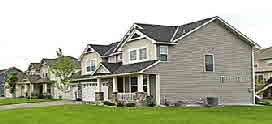 Wright County sheriff’s deputies provide policing services for Otsego, a prosperous city of 21,000 in the greater Minneapolis-St. Paul area. During the early morning hours of August 7 a 9-1-1 call alerted deputies that Jordyn Hansen, a deeply troubled 21-year old, was “having mental health challenges” and threatening the occupants of the home where he lived with a knife (for a CBS News piece on the episode, click here.) Wright County sheriff’s deputies provide policing services for Otsego, a prosperous city of 21,000 in the greater Minneapolis-St. Paul area. During the early morning hours of August 7 a 9-1-1 call alerted deputies that Jordyn Hansen, a deeply troubled 21-year old, was “having mental health challenges” and threatening the occupants of the home where he lived with a knife (for a CBS News piece on the episode, click here.)
Mr. Hansen had long suffered from emotional and drug abuse issues. He was twice committed by a court and was living with his uncle and aunt after a recent stint in rehab. When first approached Mr. Hansen seemed cooperative and agreed to accompany deputies to the hospital. But he suddenly bolted into the kitchen, grabbed a knife and fled.
More cops arrived. Police soon cornered the youth in a nearby yard. According to the Sheriff’s Dept. attempts to Tase Mr. Hansen were unsuccessful, and when he charged in with the knife two deputies shot him dead. Unfortunately, Wright County deputies don’t wear body cameras. But Minnesota’s Bureau of Criminal Apprehension, which investigates all uses of force that result in death or serious injury, informed CBS News that (as yet unreleased) patrol car video “shows Hansen ‘running towards Deputy Wilkinson’ with a knife in his hand. Wilkinson then falls backwards ‘as he fires his department handgun’.’’
According to Mr. Hansen’s aunt, deputies ignored her husband’s supplications that they immediately restrain the youth and allowed him to move freely. In her view, the lax response allowed the youth to grab the knife.
Mulberry, Crawford County, Arkansas (August 21, 2022)
A guy came in the store…He got him some water in a bottle and went outside to sit on the bench. Got up and went to the front of the store sit on the curb. I went out and told him he could not sit there. He got up and spit on me and told me he would cut my f....face up…
That’s what an Alma, Arkansas store clerk told police the morning of August 21. Two sheriff’s deputies soon observed a bicyclist who matched the evildoer’s description in nearby Mulberry. They were joined by a local cop. According to Sheriff Jimmy Diamante, the suspect, Randal Ray Worcester, 27, instantly turned violent and brutally punched a deputy in the head, causing a concussion.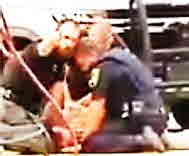
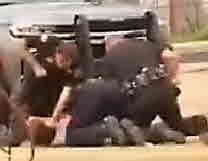 There’s no video available of that interaction. But a bystander recorded the rest of the struggle (click here for the full video and here for our edited version.) Be forewarned that it’s a difficult watch, as the officers repeatedly deliver savage blows to what quickly turns into a defeated man (see left.) Towards the end, the cops notice they’re being filmed and yell at the citizen to stop (see right). There’s no video available of that interaction. But a bystander recorded the rest of the struggle (click here for the full video and here for our edited version.) Be forewarned that it’s a difficult watch, as the officers repeatedly deliver savage blows to what quickly turns into a defeated man (see left.) Towards the end, the cops notice they’re being filmed and yell at the citizen to stop (see right).
Sheriff Diamante has little sympathy for Mr. Worcester. Although he conceded that “the citizen video is troubling to watch” and gives rise to “concerns about the use of force”, he pointed out that the suspect is currently serving a three-year suspended sentence for punching an Oklahoma City police officer in the face in 2021.
Mr. Worcester was arrested for fighting the officers and was released on $15,000 bail. He may also face charges for threatening the store clerk. His treatment, though, has drawn considerable criticism, and the U.S. Justice Department announced a civil rights investigation. For now, the three cops have been suspended from duty.
Oak Lawn, Illinois (July 27, 2022)
On July 27 Oak Lawn officers on routine patrol noticed that a vehicle lacked a front license plate and exuded a strong odor of marijuana. They pulled the car over and had the driver, a young male, step out. (Click here for ABC’s full coverage of the incident and here for our video compilation.) He was quickly patted down and stood aside. A teen passenger was then asked to exit. Hadi Abuatelah, 17, came out with a bag slung around his neck. And as he was being cursorily patted down he took off.
 Officers chased Abuatelah and soon had him on the ground. They struggled mightily over the bag. Abuatelah wouldn’t let go, and the officers delivered many blows, supposedly because they feared the Officers chased Abuatelah and soon had him on the ground. They struggled mightily over the bag. Abuatelah wouldn’t let go, and the officers delivered many blows, supposedly because they feared the 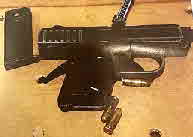 bag contained a gun. A third officer soon joined them and delivered a contact stun from his Taser. According to Oak Lawn’s police chief, that was the only way they could free the bag from the youth’s grasp. “Had the offender drawn the weapon, [the officer] could have shot him. Were they supposed to wait for him to pull it out?” And yes, there was a gun inside. It was a Raven Arms .25 pistol loaded with three rounds of ammunition. bag contained a gun. A third officer soon joined them and delivered a contact stun from his Taser. According to Oak Lawn’s police chief, that was the only way they could free the bag from the youth’s grasp. “Had the offender drawn the weapon, [the officer] could have shot him. Were they supposed to wait for him to pull it out?” And yes, there was a gun inside. It was a Raven Arms .25 pistol loaded with three rounds of ammunition.
Abuatelah suffered serious head and facial injuries and spent four days in the hospital. An officer was also injured but didn’t require hospitalization. Prosecutors charged the youth with “aggravated unlawful use of a weapon” and “unlawful possession of a firearm by a minor”; further proceedings are scheduled for September. But as one would expect, all those punches upset many citizens. According to a spokesperson for the Arab American Action Network, “the crime that everybody witnessed is the crime of Hadi being brutally assaulted by three grown men. That's the crime that we want to talk about…”
Mr. Abuatelah’s family filed a lawsuit over the cops’ “extreme and outrageous conduct”. Yet Oak Lawn’s police chief strongly defends his officers’ actions. An internal investigation is underway, but disciplinary action is not expected.
Akron, Ohio (June 27, 2022)
During the early morning hours of June 27 Akron police officers attempted to stop a vehicle for lack of a rear license plate and other violations. Its driver and sole occupant, Jayland Walker, 25, sped onto an expressway, and a pursuit ensued (click here for the official narrative and video compilation, and here for our edited version.)
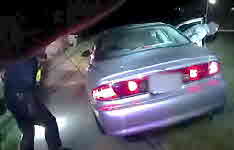 “About forty seconds” into the chase officers reported that a gunshot was fired from the vehicle. Its sound and a “flash of light” are said to have been captured by body cameras. Mr. Walker soon exited the expressway and came to a stop. Clad in a ski mask, he stepped out from the passenger side and fled on foot. Several officers took up the chase and fired Tasers, but without apparent effect. Momentarily, Mr. Walker paused and turned to face his pursuers. Officers instantly opened fire, and they kept shooting even as he fell to the ground. (An officer can be heard commanding “cease fire!”) Mr. Walker was mortally wounded. According to the autopsy, he suffered 41 entry wounds and five graze wounds. Twenty-six bullets were found in his body. “About forty seconds” into the chase officers reported that a gunshot was fired from the vehicle. Its sound and a “flash of light” are said to have been captured by body cameras. Mr. Walker soon exited the expressway and came to a stop. Clad in a ski mask, he stepped out from the passenger side and fled on foot. Several officers took up the chase and fired Tasers, but without apparent effect. Momentarily, Mr. Walker paused and turned to face his pursuers. Officers instantly opened fire, and they kept shooting even as he fell to the ground. (An officer can be heard commanding “cease fire!”) Mr. Walker was mortally wounded. According to the autopsy, he suffered 41 entry wounds and five graze wounds. Twenty-six bullets were found in his body.
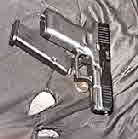 And no, Mr. Walker had not been carrying a gun. However, a pistol and a loaded magazine were found in his car (see right), and police reported that a cartridge casing consistent with the weapon was located near the spot where Mr. Walker supposedly fired a shot from his car. And no, Mr. Walker had not been carrying a gun. However, a pistol and a loaded magazine were found in his car (see right), and police reported that a cartridge casing consistent with the weapon was located near the spot where Mr. Walker supposedly fired a shot from his car.
It wasn’t these cops’ first run-in with Mr. Walker that day. According to WTDN News, the officers observed his vehicle earlier but let it go. However, they soon learned that the same car had fled from police in a nearby community a day earlier. So when they came across the vehicle for a second time they were determined to intervene.
On July 3 Akron’s mayor and police chief conducted a press briefing and played video footage. Protests broke out the next day and the city instituted a nighttime curfew. Akron subsequently designated July 13 as a “Citywide Day of Mourning for Jayland Walker”. Several officers have been placed on “administrative leave” and Ohio’s Bureau of Criminal Investigation is conducting an inquiry.
Salt Lake City, Utah (August 14, 2022)
During the early afternoon hours of Sunday, August 14, South Salt Lake officers grabbed an odd-behaving 35-year old man at a park and dropped him off at a detox facility to sober up. But Nykon Brandon didn’t stick around. An employee of a Salt Lake City brewery soon informed 9-1-1 that a crazy sort had just attacked an employee. “Definitely mental health issues. So if you’ve got mental health resources, send them out.”
 Officer bodycam videos show a pair of Salt Lake City cops chasing a very large, highly agitated man who is running across the Officer bodycam videos show a pair of Salt Lake City cops chasing a very large, highly agitated man who is running across the  highway dressed in nothing but his briefs (click here for the official compilation and here for our condensed version.) As a cop nears Nykon Brandon, 35, begins throwing punches. Soon all tumble to the ground and a violent struggle ensues. Momentarily a third officer joins in, and Mr. Brandon aggressively grabs for his gun (see right). highway dressed in nothing but his briefs (click here for the official compilation and here for our condensed version.) As a cop nears Nykon Brandon, 35, begins throwing punches. Soon all tumble to the ground and a violent struggle ensues. Momentarily a third officer joins in, and Mr. Brandon aggressively grabs for his gun (see right).
More cops quickly arrive. Officers finally gain control, apply handcuffs and  place Mr. Brandon on his stomach. As they continue to hold him in this position – from the videos, the pressure seems moderate – they verbally try to calm Mr. Brandon down. But (and this isn’t on the video) he soon stops breathing. Officers administered Narcan and chest compressions. Alas, their efforts were unsuccessful and Mr. Brandon died. place Mr. Brandon on his stomach. As they continue to hold him in this position – from the videos, the pressure seems moderate – they verbally try to calm Mr. Brandon down. But (and this isn’t on the video) he soon stops breathing. Officers administered Narcan and chest compressions. Alas, their efforts were unsuccessful and Mr. Brandon died.
Many citizens excoriated Mr. Brandon’s treatment by police. A Black Lives Matter representative argued that “stealing a beer does not equate to the death penalty.” BLM also complains that no video evidence was provided that confirms any lifesaving attempts. Police announced that the final video wasn’t released “out of consideration for Brandon’s family”.
Stockton, California (February 22, 2022)
Fixed surveillance cameras show that on February 22 Tracy Gaeta was recklessly motoring through Stockton. She sped the wrong way down a one-way street, struck the rear of a stopped police car, and ran a red light. (Click here for the official video compilation, and here for our edited version).
 K-9 officer Kyle Ribera ultimately chased Ms. Gaeta’s car into a dead end. But as he began to exit the patrol car, Ms. Gaeta shifted into reverse and rammed him. That knocked Officer Ribera back into the car and caused him to strike his head. He promptly emptied his pistol at Ms. Gaeta’s vehicle, shattering its back window (see left). K-9 officer Kyle Ribera ultimately chased Ms. Gaeta’s car into a dead end. But as he began to exit the patrol car, Ms. Gaeta shifted into reverse and rammed him. That knocked Officer Ribera back into the car and caused him to strike his head. He promptly emptied his pistol at Ms. Gaeta’s vehicle, shattering its back window (see left).
Quickly reloading, Officer Ribera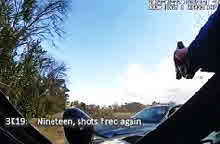 commanded “hands up.” But Ms. Gaeta again drove backwards, swinging her car sideways so that her seat faced the cop’s car. Officer Ribera promptly fired a second volley, which seemed aimed directly at the driver (see right). In all, he reportedly discharged 33 shots. Ms. Gaeta’s car stopped moving. Officer Ribera promptly summoned an ambulance. commanded “hands up.” But Ms. Gaeta again drove backwards, swinging her car sideways so that her seat faced the cop’s car. Officer Ribera promptly fired a second volley, which seemed aimed directly at the driver (see right). In all, he reportedly discharged 33 shots. Ms. Gaeta’s car stopped moving. Officer Ribera promptly summoned an ambulance.
Officer Ribera probably assumed that his antagonist was male. After all, the cop whose vehicle Ms. Gaeta first struck had repeatedly referred to its driver as a “he”. As it turns out, the errant motorist was a 54-year old grandmother from Sacramento. Her family was surprised to learn that she had wound up in Stockton, fifty miles from home. Their lawyer described Ms. Gaeta as a “victim of preventable police violence.” He said that she had neither a “serious mental illness” nor a criminal record but was “depressed from a recent breakup.” He insisted that “no matter what was going on with her — even if she had committed a heinous crime — [the officer] didn’t have the right to shoot her.”
Did the cop break the rules? Stockton police regulations require that officers “make every effort to avoid putting themselves into a position where they could be struck by a fleeing vehicle, requiring them to use a firearm to protect themselves.” They may fire at moving vehicles only “to end an imminent threat to human life”. Whether Officer Ribera was in compliance is still being sorted out. Still, he seems a well-regarded member of the force (click here for his appearance in a “COPS” segment) and to date no discipline has been imposed.
Discussion
These incidents came to our attention because of their poor, newsworthy endings. We don’t claim that they broadly represent police-citizen encounters. Hopefully, they don’t. After all, only one person threatened a cop with a weapon, and that was a kitchen knife. Yet three of the six citizens were shot dead. A fourth perished while under restraint, while the two who survived endured supposedly unwarranted beatings. We’ll begin with the fatal encounters.
Otsego. We’re reluctant to fault a deputy for shooting someone who lunges with a knife. Even when multiple officers are on scene, encounters with the emotionally disturbed (see, for example, the November 2019 episode in Los Angeles) are inevitably fraught. Whenever possible, the best approach to dealing with the mentally ill is to immediately gain physical control. So we’re critical of the deputies’ failure to promptly take custody of the youth, as his guardians apparently asked them to do.
 Akron. This episode began with an attempted car stop that turned into a pursuit, during which the driver reportedly fired a shot. As the image shows, he ultimately stepped out wearing a full ski mask. That may have confirmed the fear that he posed a lethal threat. And when he suddenly stopped and swiveled, a nervous cop fired. As so frequently happens, that discharge apparently led his colleagues to open fire. Yet their antagonist turned out to be unarmed. He left his gun in the car. Akron. This episode began with an attempted car stop that turned into a pursuit, during which the driver reportedly fired a shot. As the image shows, he ultimately stepped out wearing a full ski mask. That may have confirmed the fear that he posed a lethal threat. And when he suddenly stopped and swiveled, a nervous cop fired. As so frequently happens, that discharge apparently led his colleagues to open fire. Yet their antagonist turned out to be unarmed. He left his gun in the car.
Police personalities vary. “Three Inexplicable Shootings” suggests that “cops who are easily rattled, risk-intolerant, impulsive or aggressive are more likely to resort to force or apply it inappropriately.” Had Akron’s officer been more level-headed, things might have turned out peaceably. Yet his city, as our opening graph indicates, is a fraught place. As we suggested in “Speed Kills”, “violent experiences…play a major role in fashioning the lens through which officers perceive and respond to threats.” Might a combination of personal characteristics and the nature of one’s community virtually doom some cops to over-react?
How could it not?
Salt Lake City. We found nothing exceptional about the tackling of a naked, disturbed man. Police were clearly trying to “immediately take custody” before an innocent citizen got hurt. However, the officers were heavily criticized for placing Mr. Brandon – a very large man – on his stomach and keeping him there. After all, that’s what supposedly led to the deaths of Ronald Greene and, one year later, George Floyd. And while the pressure applied on Mr. Brandon seems far less constant and severe than what happened in those cases, he nonetheless lost consciousness and died.
Autopsy results haven’t been revealed, so we don’t know whether Mr. Brandon had ingested drugs. If so, his wild, aggressive behavior would suggest that he had been in the throes of excited delirium. If so, any struggle could have proven fatal. Verbally calming the man down, as the officers ultimately tried to do, was a good move. But placing non-combative persons in a side recovery position is also recommended. However, from the videos that have been released, there’s no indication this was done.
Stockton. Would the K-9 cop have knowingly emptied his pistol at a crazed middle-aged grandmother? We’ve never been in that predicament, but out best guess is a resounding – no! Had the vehicle been in fact registered to Ms. Gaeta (we don’t know), and had dispatchers passed that on, the K-9 officer may have reacted differently. Another cop, though, had already mistakenly referred to the driver as a “he.” So a lack of information – and particularly, accurate information – may have played a role.
On the other hand, Stockton is a very violent place – indeed, it’s by far the worst of our group. Considering what already took place (remember, another police car had been struck) the cop may have gone into survival mode. As in Akron, officer personality may have propelled the use of lethal force.
Mulberry. When Ray Worcester was first confronted, the 27-year old Arkansas man reportedly punched a deputy in the head. That wasn’t captured on video. But everything that followed was recorded by a bystander.
Arkansas Governor Asa Hutchinson pronounced the beating – for that’s what it clearly was – as “reprehensible and “not consistent” with what cops are taught. To be sure, Mr. Worcester seems a violent sort. But the cops who delivered the blows came off as his badge-wearing equivalents. It’s yet another example of cops setting aside their craft in favor of satisfying their inner demons. Yet as we entitled our essay about George Floyd, “Punishment Isn’t a Cop’s Job.” Really, it’s not. (See 1/25/23 update, below.)
Be sure to check out our homepage and sign up for our newsletter
Oak Lawn. Officer bodycams reveal that police initially treated Mr. Abuatelah courteously. In our opinion, far too courteously. Although he exited the vehicle with a (closed) bag slung over a shoulder, it went initially unexamined, and his pat-down (left image) seemed at best cursory. A lack of meaningful restraint allowed the teen to bolt (right image), setting off a foot chase that ended with what critics describe as a beating.
 We don’t agree. During the struggle officers likely We don’t agree. During the struggle officers likely sensed by touch that Mr. Abuatelah’s bag might hold a gun. Bodycam videos support their claim that the blows were intended to get the youth to let go of the bag. But he resolutely held on. That forced a third cop to come in and jolt him with a Taser. Notably, while there’s been plenty of criticism of the cops, more than a few citizens have also come out in their support. sensed by touch that Mr. Abuatelah’s bag might hold a gun. Bodycam videos support their claim that the blows were intended to get the youth to let go of the bag. But he resolutely held on. That forced a third cop to come in and jolt him with a Taser. Notably, while there’s been plenty of criticism of the cops, more than a few citizens have also come out in their support.
Here, our reaction is much the same as in Otsego. While officers should seek to promote voluntary compliance, being overly casual invites misbehavior. Taking prompt control of individuals and situations can avert the need to use force. And that, too, is what the “craft of policing” is all about.
UPDATES (scroll)
12/20/24 Hadi Abuatelah, a 17-year old Illinois youth, had a gun in his bag. But the Oak Lawn officers who stopped his car in July 2022 because it missed a license plate didn’t know that. When Abuatelah ran off, the officers chased him down. And as they piled on, officer Patrick O’Donnell repeatedly struck the teen in the head. That got him charged with aggravated battery and official misconduct. But yesterday, one day before trial, the Cook County Attorney dismissed the case. In its opinion, there’s simply not enough to prove guilt beyond a reasonable doubt. And the protests are on.
10/11/24 Having pled guilty to Federal civil rights violations, ex-Crawford Co., Arkansas deputy Levi White drew 63 months in Federal prison, and his former partner Zackary King got twelve, for brutally assaulting a man who shoplifted a water bottle. Although “R.W.” (Randal Ray Worcester, 26) wound up lying helplessly on the ground, White delivered repeated blows to his head, then violently slammed it to the ground. And, yes, a bystander captured it all on video. Video
12/19/23 Surveillance cameras have become commonplace. Alas, so have bandits wearing ski-masks. And it’s not just about smash-and-grabs. In Philadelphia, a series of brazen killings by mask-clad shooters led the city to enact an ordinance that forbids their wear “in parks, schools, day care centers, transit and city-owned buildings.” Violators can be fined $250, or $2,000 if they are masked while committing a crime. Similar bans are in effect in several States.
10/20/23 In 2004 a Florida jury deadlocked on charges that Leonard Cure was the armed man who robbed a Broward County drug store a year earlier. Convicted at retrial, he drew a life term due to previous convictions for robbery and GTA. Sixteen years later prosecutors had Cure exonerated because of evidentiary problems, and in 2020 he was a free man. On October 16, 2023 a Georgia deputy tried to arrest him for driving over 100 mph. Cure violently resisted, and the officer shot him dead. Video
6/19/23 In June 2022 Jayland Walker apparently fired a shot at Akron, Ohio police officers who were pursuing him for traffic violations. He eventually stopped and bolted from his car, unarmed but wearing a full ski mask. A group of eight officers unleashed dozens of rounds, shooting him dead. In April 2023 a grand jury declined to indict any of the officers. Alleging “a culture of violence and racism”, Walker’s family has just filed a $45 million lawsuit against the city.
4/18/23 Grand jurors declined to indict the Akron, Ohio police officers who unleashed dozens of shots, killing Jayland Walker as the ski-mask clad man paused and turned to face them during a nighttime foot chase. Walker bolted from his car after a pursuit during which he fired one round at the officers from the vehicle. A pistol and loaded magazine were found in the car, and a bullet casing was recovered from the area where he fired the gun. Officers said they shot because they thought that Walker was still armed.
3/22/23 Released video depicts the seven Virginia sheriff’s deputies who were charged with murdering Irvo Otieno piling on the mentally-distraught man inside a hospital reception area and pinning him to the floor. They persist for nearly five minutes before rolling him onto his back. Meanwhile medical staff mostly stand back.
On 4/3/23 the medical examiner ruled that the cause of death was "positional and mechanical asphyxia with restraints."
3/17/23 Seven Henrico County, Virginia sheriff’s deputies and three hospital
employees were charged with murdering Irvo Otieno, a 28-year old Black man with mental problems who was being admitted to a
hospital after spending several days in custody. During the transfer, deputies allegedly pinned the shackled man to the ground for
a prolonged period and smothered him to death. And even as Mr. Otieno turned “lifeless” and stopped breathing,
hospital staff supposedly failed to act.
1/25/23 Former Crawford County, Arkansas, Sheriff’s Deputies Levi White and Zackary King were fired after an August 2022 encounter in which they repeatedly punched Randal Ray Worcester, 27, a local man who misbehaved at a convenience store (click here for our brief video clip.) A Federal grand jury has now indicted them for civil rights offenses that carry a 10-year prison term and a $250,000 fine.
10/10/22 A San Antonio, Tx. police officer spotted a car that eluded him a day earlier parked at a MacDonald’s. So he walked up, opened the driver’s door and ordered its teen driver - he was munching a burger - to get out. But the youth promptly started the car and threw it into reverse. Its door bumped the cop, and he opened fire. Erik Cantu, 17, was badly wounded. And three days later, officer James Brennand, a rookie still on probation, was fired. Video
|
Did you enjoy this post? Be sure to explore the homepage and topical index!
Home Top Permalink Print/Save Feedback
RELATED POSTS
Special topics: Craft of Policing
When Worlds Collide Blows to the Head Were Never O.K. What Were They Thinking? (I)
Another Victim: The Craft of Policing Violent and Vulnerable When Must Cops Shoot? (I)
Speed Kills Three (In?)explicable Shootings Working Scared Is it Always About Race?
Making Sausage A Dead Marine, and a Lot of Questions The Chase is On
You Can’t “Manage” Your Way Out of Rampart
Posted 8/15/22
WHAT WERE THEY THINKING? AND…WHY?
Violent communities frighten their inhabitants. And their cops.
For Police Issues by Julius (Jay) Wachtel. Lawton would seem a promising place. With a population just short of one-hundred thousand, the sixth-largest city in Oklahoma is a military/industrial hub, home to Ft. Sill and a major Goodyear plant. Yet with a median household income of $47,690 and 18.4 percent poverty rate, Lawton substantially lags behind the “Sooner State’s” $53,840 MHI and 14.3% poverty rate. Economy-wise, Lawton winds up second-worst of Oklahoma’s ten largest cities.

It’s also second-worst when it comes to violence. UCR crime data suggests that the community is a truly dangerous place. Lawton’s 2019 violent crime rate of 926/100,000 was more than twice Oklahoma’s 432 and second only to Tulsa’s 987. And when it comes to murder Lawton was the worst of the bunch: its sixteen homicides in 2019 produced a rate of 16.3, well beyond Tulsa’s 13.7 and nearly two and one-half times the state’s 6.7. (We used the UCR as the FBI’s “Crime Data Explorer” remains a work in progress.)
Click here for the complete collection of compliance and force essays
Over the years we’ve repeatedly noted that poverty and violence are closely linked. This graph orders Oklahoma’s ten largest cities by poverty (black bars, least poor on the left). As poverty increases, what’s the trend for violence (red bars)?

Well, Lawton clearly has problems. But why obsess about them? Because on December 5, 2021 the city was the site of a particularly offensive police shooting. Indeed, the bodycam footage is so shocking that we didn’t place a copy on our website. (It’s available on Lawton PD’s YouTube channel. Click here.)
According to the Comanche County District Attorney, Lawton police responded to a caller who said that a man who was the subject of a protective order had entered a residence, was armed with a gun, and wouldn’t let the person who obtained the order leave. That intruder turned out to be Quadry Sanders, 29. Officers Robert Hinkle and Nathan Ronan responded. On arrival they used their P.A. to announce their presence. A woman – the “protected” person, Mr. Sanders’ wife – shortly exited the home and crossed the street to meet with police.
Mr. Sanders then walked outside and quickly ran back in. The following stills, which we produced from officer bodycam video (Mr. Sanders’ head is purposely blurred) show what happened when he left a second time. (Check out the photo of the residence at top. That refrigerator and trash can were in the carport, to the right of the front door.) On this occasion Mr. Sanders is carrying a ball cap (left image). An officer, reportedly Hinkle, approaches, yelling commands. Mr. Sanders turns as if to go back in and the cop’s view becomes restricted by the refrigerator (center image). As the officer keeps coming Sanders pauses and his right hand moves to his midsection (right image).
 |
Officer Hinkle instantly sidesteps the appliance and repeatedly fires (four shots, according to the D.A.) Sanders is struck and goes down. As he struggles to rise officer Hinkle fires again, reportedly seven times. Officer Ronan then fires four times. In all, Mr. Sanders was struck by twelve rounds. He died soon after arriving at the hospital. And no, he hadn’t been carrying a gun.
Following an investigation by State authorities, officers Hinkle and Ronan were fired January 7. On May 6th. they were charged with manslaughter in the first degree, which is punishable by a minimum prison term of four years. They were released on $25,000 bond.
We’ve often probed police shootings. See, for example, our two-parter, “When Must Cops Shoot?” (I) and (II). Cops have limited resources and, often, a dearth of information; especially, accurate information. Yet they’re expected to resolve – peacefully, if at all possible – conflicted, rapidly evolving situations. To be sure, that might require they “slow down.” And as we harped in “Speed Kills,” taking the time to correctly assess things can work to everyone’s benefit. Alas, not all situations afford the luxury of time. There are other complications. Some citizens might be reluctant to comply with police, and a niggling few may prove determined to misbehave. What’s more, cops are human, and we know the foibles that implies. Given the complexity of their working environment, the availability of guns and other weapons, and, in some communities, the constant drumbeat of violence, it’s little wonder that officers will occasionally get it wrong. Lethally wrong.
Let’s apply some of these concepts to what happened in Lawton. According to police, in addition to mentioning the protective order, the 9-1-1 caller complained that “Sanders was waving a gun inside the house.” That was of course passed on to the officers.
Was the information accurate? According to (former) cop Hinkle’s defense lawyer, the officers had been “repeatedly” called to the home because of Mr. Sanders’ behavior. They thought that he was reaching for a gun in his pants. And a gun was found on a table inside the house.
However, the seemingly compelling Sanders=bad guy scenario may have been somewhat exaggerated. Local T.V. station KSWO reported that court records indeed confirmed that Mr. Sanders was pending prosecution for spousal abuse. But the protective order had expired. In fact, his wife told reporters that the couple intended to reconcile, and that she had asked Mr. Sanders to come over and expel an unwanted visitor. Assumedly, it was that “visitor” – their relationship to Mr. Sanders’ wife is to us unknown – who dialed 9-1-1.
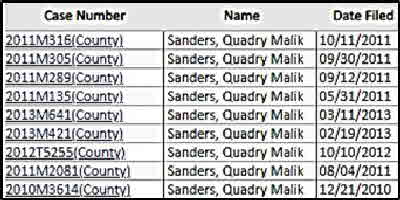 Our review of court files reveals that between 2010 and 2013, while residing in Colorado, Mr. Sanders was repeatedly fined, placed on probation and received brief jail terms for a range of misdemeanor offenses, including criminal mischief, shoplifting, assault, harassment, disorderly conduct, resisting an officer, flight to avoid prosecution and failure to appear (see left). His misbehavior apparently continued in Oklahoma. A search returned through the State portal revealed that between February 2015 and October 2021 Mr. Sanders was arrested by Lawton police on at least three occasions for various misdemeanors, including domestic assault and resisting arrest. Our review of court files reveals that between 2010 and 2013, while residing in Colorado, Mr. Sanders was repeatedly fined, placed on probation and received brief jail terms for a range of misdemeanor offenses, including criminal mischief, shoplifting, assault, harassment, disorderly conduct, resisting an officer, flight to avoid prosecution and failure to appear (see left). His misbehavior apparently continued in Oklahoma. A search returned through the State portal revealed that between February 2015 and October 2021 Mr. Sanders was arrested by Lawton police on at least three occasions for various misdemeanors, including domestic assault and resisting arrest.
Given the officers’ prior contacts with Mr. Sanders and what they knew about his past, the man likely presented a threat. Add in what they thought they knew – that he had (again!) violated a protective order and was supposedly “waving a gun” – and that hand dropping to the beltline might have acquired special meaning. After all, violence and gunplay are no strangers to Lawton. Neither are threats to police. Indeed, only one year had passed since officer Ronan had shot and killed an armed man.
And that brings us to the cops. According to KSWO, officer Nathan Ronan was a Lawton cop for four years and had no reprimands on file. Lawton police chief James Smith concluded that the man officer Ronan shot and killed in January 2021, Zonterious Johnson, had exchanged gunfire with another person and, during a subsequent foot chase, threatened officer Ronan with a 9mm. pistol. Officer Ronan’s actions were investigated by State agents and local prosecutors and he was cleared of wrongdoing.
Officer Robert Hinkle, who was the first to fire on Mr. Sanders and discharged the most shots, was a five-year veteran. According to KSWO his disciplinary record consisted of three suspensions, “all of which pertained to damaging a police unit [i.e., a vehicle].”
Be sure to check out our homepage and sign up for our newsletter
Mr. Sanders was a Black man. Might race have figured in his killing? Former officer Hinkle, who fired first, is also Black. His partner, former officer Ronan, is White. In “Black on Black” we discussed the 2019 death of Mr. George Robinson, a Black 62-year old resident of violence-ridden Jackson, Mississippi. Three officers, each a Black man, spotted Mr. Robinson as he apparently sold drugs from his car. Their rough treatment of Mr. Robinson allegedly caused a fatal brain bleed, and each cop wound up being charged with second-degree murder. (Two were ultimately acquitted and one was convicted, but of manslaughter.)
Updates to that post mention similar episodes elsewhere. But speculating about race is just that: speculation. Still, it’s true that needlessly lethal episodes typically take place in poor, violence-stricken neighborhoods and the victims are often persons of color. Officer skillsets vary, and it may be that some cops, Black and White alike, let their frustrations override their better judgment. Here’s a bit of self-plagiarism from “Black on Black”:
We approached this incident as we do all: tabula rasa. Still, when your author paused while building fancy tables to consider his own experiences carrying a badge, Mr. Robinson didn’t strike him as much of a threat. Jackson’s cops, though, work in a very unforgiving environment. When the now-indicted officers happened on someone who seemed to be taking advantage of the city’s troubles, their exasperation may have led to an overly aggressive response. One that caused an old man to fall and crack his skull…Might Jackson’s struggle with crime and violence affect how its officers deal with citizens? Could it sometimes lead to poor decisions? Really, how could it not?
Ditto, Lawton.
UPDATES (scroll)
10/15/24 An in-depth assessment of the consequences of officer exposure to the “cumulative stress of policing” reveals that an accumulation of stressful and traumatic events, and the frequent use of force, can lead to depression and PTSD. Officers involved in an episode that leads to a death seem particularly apt to “quietly deal with trauma in ways that cause their performance or judgment to slip on the streets.”
4/25/23 According to the Post, Jackson, Mississippi’s capital city, had the nation’s worst 2021 murder rate. A quarter of its residents, who are mostly Black, live in poverty. To supplement Jackson’s beset police force, the Governor has extended the authority of the Capitol Police to the whole city, not just its government buildings. Calling it a “state takeover of Jackson,” the NAACP objects. Litigation is pending.
4/19/23 After listening to a surreptitious tape of their chat, Oklahoma’s Governor demanded the resignation of rural McCurtain County Sheriff Kevin Clardy, a sheriff’s captain and two county officials for engaging in a racist diatribe against Black persons. On the recording, a County commissioner suggests going back to hangings. “But you can’t do that anymore. They got more rights than we got.” And the sheriff goes along. He’s since promised to criminally charge the newspaper publisher who purposely left his recorder behind (and turned on) after leaving the meeting.
9/17/22 In two beset Tulsa neighborhoods, a public-private partnership that enhanced the police presence, “shifted high-risk individuals away” through eviction and provided enhanced security and surveillance significantly reduced total crime. But there was no significant reduction of disorderliness, and assaults only fell significantly in one location.
9/1/22 Columbus, Ohio resident Donovan Lewis, 20, had arrest warrants for “improper handling of a firearm, domestic violence, and assault” when police officers rousted him from bed during the early morning hours of August 30. And as the man raised his hand, gripping what turned out to be a vape pen, a “30-year veteran” of the force shot him dead. State officers are investigating.
|
Did you enjoy this post? Be sure to explore the homepage and topical index!
Home Top Permalink Print/Save Feedback
RELATED POSTS
Special topics: Craft of Policing
When Worlds Collide What Were They Thinking? (II) Fair but Firm Black on Black
When Must Cops Shoot? (I) (II) Speed Kills
Posted 6/20/22
TENACITY IS GREAT – UNTIL IT’S NOT
An aggressive citizen, a dogged cop, and a tragic outcome
For Police Issues by Julius (Jay) Wachtel. In 2014, after a decade-long stay in an African refugee camp, an eighteen year old Congolese youth accompanied his family to the U.S. But while his parents and siblings settled in Lansing, Michigan’s capital city, Patrick Lyoya soon relocated to Grand Rapids. He fathered two daughters, of whom little is known, and bounced between jobs.
Along the way, he also drew lots of attention from the cops. According to Grand Rapids police, Mr. Lyoya amassed eight misdemeanor convictions in Michigan and, in Illinois, a felony conviction for aggravated drunken driving. A recent complaint by the mother of one of his daughters that he “punched her in the face and slammed her head into a car after she refused to let him take her new bedsheets” led to a warrant for domestic violence. MLive and WWMT reported that Mr. Lyoya had a prior conviction for that offense. Their review of criminal records revealed that he also had three convictions for drunk driving, plus convictions for unlawful use of a motor vehicle and driving on a suspended license, and was awaiting sentencing for a 2021 DUI that could involve prison time. As one would expect, Mr. Lyoya’s Michigan driver license had been revoked.
Click here for the complete collection of compliance and force essays
None of that was known to Christopher Schurr, the Grand Rapids police officer whose attention was drawn to the vehicle that Mr. Lyoya was driving on the morning of April 4th. Officer Schurr’s lawyer would later assert that his client, who was patrolling alone, stopped the car because it was proceeding “suspiciously slowly.” That seems plausible, as according to the Coroner (yes, that’s how things turned out) Mr. Lyoya’s post-mortem blood alcohol level was .29, more than three times Michigan’s .08 limit.
Officer Schurr quickly ran the plate. It came back to a different vehicle. Figuring that something was up – maybe the car was stolen? – he pulled it over. Mr. Lyoya promptly exited (he had a passenger, who remained seated). Officer Schurr walked up and promptly mentioned the mismatched plate. Mr. Lyoya didn’t offer an explanation. Neither could he produce the driver’s license that he said he had, as one didn’t exist. Caught in a predicament, he simply walked away. (For the GRPD’s montage of videos from the police car, the officer’s body camera, a residential camera and the passenger’s cellphone, click here. For our condensed, annotated version, click here. WARNING: they’re graphic!)
At the time Officer Schurr didn’t know who Mr. Lyola was. And when he tried to stop the possible car thief from leaving, Mr. Lyoya resisted and ran off.
Officer Schurr chased Mr. Lyola and radioed for backup. He also supposedly fired his Taser twice, but the probes evidently missed. He finally tackled Mr. Lyoya, then tried to walk him to the police car.
Mr. Lyoya, though, kept struggling. Officer Schurr pulled his Taser, which he probably intended to use it in “drive stun” mode to gain compliance. But before he could, Mr. Lyoya grabbed the device.
Officer Schurr repeatedly told Mr. Lyoya to let go. But he wouldn’t. In fact, he quickly gained full possession of the device. Officer Schurr again took Lyola to the mat. During their final struggle the cop pulled his pistol and pressed it against Mr. Lyoya’s upper body. And, within moments, fired.
He...fired?
According to the autopsy, Mr. Lyoya died from a bullet that entered the back of his head. To his family, friends and, apparently, many others, what Officer Schurr did was an execution. We’re unaware of any policing expert who’s endorsed the shooting as the appropriate response. Several, though, have pointed out that the officer faced considerable risk from a strong, aggressive and seemingly determined adversary. Ditto the Grand Rapids Police Officers Association. In their view, a police officer “has the legal right to protect themselves and community in a volatile dangerous situation such as this, in order to return to his/her family at the end of their shift.”
That’s the defense that Mark Dodge, the (now, former) cop’s lawyer has advanced. Alleging that Mr. Lyoya’s behavior gave the officer plentiful cause to believe that he was “in danger of serious bodily injury or death,” he pronounced the shooting “legally justified.” But Kent County prosecutors disagreed. On June 9 they charged Christopher Schurr with second-degree murder, which Michigan defines as a “spur of the moment” act that’s either unplanned and intentional or caused “by a reckless disregard for human life.” Officer Schurr didn’t contest his proposed termination, and he was fired on June 10.
We’re not convinced that murder charges are appropriate. Your writer recalls rolling around with an aggressive citizen on the porch of his home. Fortunately, a neighbor came to help, and handcuffs were soon in place. No one, though, stepped in to help Officer Schurr. Still, drawing the pistol seems a serious lapse in judgment, and the shooting is inexcusable. Officer Schurr could have jumped away and gained some distance. If he had in fact twice fired the Taser, it would be out of darts; if not, and Mr. Lyoya aimed the device at him, shooting could have been an appropriate response.
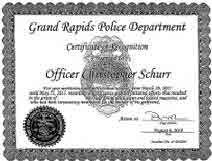 Officer Schurr seemed clearly determined to subdue the large, frenzied man and “finish” the job on his own. Indeed, his temperament may not have allowed him to wait for backup. During his seven years of service Officer Schurr earned a slew of commendations and received no significant demerits. According to a former Detroit police chief who reviewed his personnel file, Officer Schurr was a vigorous cop who consistently displayed initiative and determination. And a predilection for taking action: Officer Schurr seemed clearly determined to subdue the large, frenzied man and “finish” the job on his own. Indeed, his temperament may not have allowed him to wait for backup. During his seven years of service Officer Schurr earned a slew of commendations and received no significant demerits. According to a former Detroit police chief who reviewed his personnel file, Officer Schurr was a vigorous cop who consistently displayed initiative and determination. And a predilection for taking action:
What I noticed is that he does a lot of stops. There’s a lot of commendations that are made and given to him by his supervisors (because) of the stops and what he recovers whether there’s guns or narcotics...There was nothing in his file that I saw in his file that said he was doing anything that was egregious or that he was doing any stops that were unwarranted.
While Officer Schurr was definitely the tenacious sort, nothing that’s been revealed about his prior service suggests that he lacked self-control or misused force. He definitely doesn’t resemble the chronically misbehaving cops we discussed in “Third, Fourth and Fifth Chances.”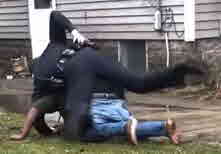 So why did he shoot? Grab another look at the last four images. (If you’ve got the stomach for it, click here for a video of those final few moments.) As they struggle – keep in mind, Mr. Lyoya now has the Taser – Officer Schurr draws his pistol and seemingly shoves the muzzle against Mr. Lyoya’s upper body. Perhaps he wanted his adversary to feel the gun’s presence, realize he could be shot, and give up. But Mr. Lyoya kept struggling. If the officer’s index finger was on or near the trigger, a jolt could have caused an unintentional discharge. So why did he shoot? Grab another look at the last four images. (If you’ve got the stomach for it, click here for a video of those final few moments.) As they struggle – keep in mind, Mr. Lyoya now has the Taser – Officer Schurr draws his pistol and seemingly shoves the muzzle against Mr. Lyoya’s upper body. Perhaps he wanted his adversary to feel the gun’s presence, realize he could be shot, and give up. But Mr. Lyoya kept struggling. If the officer’s index finger was on or near the trigger, a jolt could have caused an unintentional discharge.
That’s our best guess. Of course, police aren’t trained to use guns this way. But if that’s what Officer Schurr intended, the shooting seems much more a fit for involuntary manslaughter than murder.
Mr. Lyoya was as determined a soul as the cop, but to opposite ends. Voluntary compliance wasn’t in his nature. He was on probation, by no means supposed to be driving, and the legal ownership of that vehicle was unclear (its license plate apparently belongs to a friend.) Being drunk can easily lead to bad decisions, and given his past and present legal baggage, he undoubtedly feared what would come.
Be sure to check out our homepage and sign up for our newsletter
Other than giving its participants personality transplants, what could have prevented that needlessly tragic ending? Grand Rapids has reportedly shifted to two-officer cars, at least for the time being. That  can help. But it’s not a guaranteed fix. In June, 2020, two Atlanta cops tangled with an intoxicated man who was every bit as determined and combative as Mr. Lyoya (“Is it Ever OK to Shoot Someone in the Back?”) He was also shot dead. That came after he punched one cop, snatched his Taser (see image), and, during a foot chase, fired it at the other. And no, he hadn’t been fleeing from a crime scene. Rayshard Brooks fell asleep behind the wheel of his car in a Wendy’s drive-through, and employees couldn’t wake him. So they called police. can help. But it’s not a guaranteed fix. In June, 2020, two Atlanta cops tangled with an intoxicated man who was every bit as determined and combative as Mr. Lyoya (“Is it Ever OK to Shoot Someone in the Back?”) He was also shot dead. That came after he punched one cop, snatched his Taser (see image), and, during a foot chase, fired it at the other. And no, he hadn’t been fleeing from a crime scene. Rayshard Brooks fell asleep behind the wheel of his car in a Wendy’s drive-through, and employees couldn’t wake him. So they called police.
Catastrophic street encounters (remember, um, George Floyd?) have seriously undermined the relationship between citizens and police. Natch, Police Issues has a “better idea.” Given the lousy decisions that human beings often make, and especially while they’re under the influence of alcohol or drugs, insistently trying to score a “capture” can yield, well, a corpse. In these fraught times, when voluntary compliance seems in particularly short supply, cops – especially, those working alone – should consider letting pesky citizens go. (“Backing Off” happens to be the title of a recent post. “Want Happy Endings? Don’t Chase” is another.)
Mind you, we’re not suggesting that shooters, robbers or evildoers flaunting knives or guns be ignored. However, none of that applied to Mr. Lyoya. Once backup arrived, officers could have interviewed the passenger, impounded the car, and tacked their findings onto the naughty one’s bucket list. Instead, a man is dead, a city has been torn asunder, and a once-promising cop faces murder charges. Really, there is room for a “reset.” Sometimes both citizens and police need to be saved from themselves.
UPDATES (scroll)
6/19/25 On May 22, 2025, two weeks after a hopelessly deadlocked jury derailed the trial of former Grand Rapids, MI police officer Christopher Schurr for murdering Patrick Lyoya, Kent County prosecutor Chris Becker announced that the highly controversial case would not be retried. Both the NAACP and the Urban League have implored Attorney General Dana Nessel to step in. A.G. Nessel once told reporters that she would prosecute if asked. But her present intentions are unknown.
5/9/25 A mistrial was declared after jurors deadlocked in the case against former Grand Rapids, Michigan officer Christopher Schurr, who is accused of murder and manslaughter for the April 2022 shooting death of Patrick Lyoya. Schurr had stopped Lyoya for a traffic violation. Lyoya, who was unlicensed, drunk and had a domestic violence warrant, bolted. Schurr chased after him. During a violent struggle, Lyoya grabbed Schurr’s Taser, and the officer shot him dead. Defense experts testified that Lyoya’s actions justified the shooting; prosecution experts countered that Schurr could have simply let the man go.
11/1/22 Former Grand Rapids, Michigan police officer Christopher Schurr, who shot and killed Patrick Lyoya after the man ran away from a traffic stop, forcefully resisted arrest, and took control of Schurr’s Taser, was ordered to stand trial for second-degree murder. According to the judge, at this stage his role was limited to a “very limited check” on prosecutors, and he believed that they had offered sufficient probable cause to bring the case to trial.
|
Did you enjoy this post? Be sure to explore the homepage and topical index!
Home Top Permalink Print/Save Feedback
RELATED POSTS
Special topics: Craft of Policing
A Lethal Distraction Backing Off Third, Fourth and Fifth Chances
Want Happy Endings? Don’t Chase Is it Ever OK to Shoot Someone in the Back? (II) Fair But Firm
Posted 1/4/22
WHO’S IN CHARGE?
An eager cop rushes in and opens fire.
He kills the suspect. And an innocent child.
For Police Issues by Julius (Jay) Wachtel. One cannot envision a more soul-crushing example of well-intentioned policing gone horribly wrong. On December 23, Daniel Elena Lopez, 24, a convicted felon under local supervision, pushed his bicycle into a North Hollywood Burlington clothing store where 14-year old Valentina Orellana-Peralta and her mother were selecting a dress for the girl’s forthcoming quinceanera. Wielding a lock and chain, Lopez rampaged around the store, prompting employees to call 9-1-1 and order customers to leave. Valentina and her mother apparently took cover in a dressing room. Within minutes a bullet fired by an officer pierced a wall and struck the youngster in the chest. She died in her mother’s arms.
 Let’s begin by using LAPD’s officer bodycam videos to describe what took place. (For the agency’s full, 35-minute compilation release click here. For our condensed, 8-minute version click here.) Let’s begin by using LAPD’s officer bodycam videos to describe what took place. (For the agency’s full, 35-minute compilation release click here. For our condensed, 8-minute version click here.)
At the start of the 9-1-1 call, a Burlington employee reported that an intruder with a bike was assaulting people with a lock and chain. But another employee then mentioned – and confirmed when asked – that the man was armed and had fired a gun.
Click here for the complete collection of compliance and force essays
As it turns out, Lopez did not have a gun. During the early stages of his rampage, Lopez repeatedly swung the lock and chain, and its impact on walls and such may have sounded like gunfire. In any event, this incorrect, misleading and, one can imagine, highly disturbing information was passed on to responding officers.
On arrival, a police supervisor spoke with a Burlington employee. The worker (his face is obscured in the video) said that the intruder had gone “pantless” (a store video shows Lopez stripping to his underwear) and was “smashing things around” with a bike lock. He said nothing about a gun, nor did the officer ask.
Burlington’s in-store cameras depict Lopez’s arrival. Chain and lock slung over his shoulder, he wheels in a bicycle, takes it up the escalator, then dumps it on the ground. Customers take notice of the oddball and give him a wide berth.
Lopez walks around, flinging the chain at objects and at people. He then goes back downstairs, discards his trousers and briefly exits the store.
Lopez quickly returns and rides the escalator back up to the sales floor. Employees had sought to evacuate the premises, but some customers apparently remained. Lopez spots one of the exceptions and attacks her with the chain. He then drags his victim through the aisles, pausing to inflict additional beatings.
By then officers are already in the store. They begin closing in. But their formation is soon taken over by a latecomer, Officer Jones. His bodycam depicts him grabbing an AR-style rifle from a police car, bolting up the escalator, then imploring a moving column of cops to “slow down” so he can “take point with the rifle.” And he quickly does.
Officer Jones charges ahead. Unnerved by his aggressive tenor, a fellow cop yells at him to “slow it down.” But he doesn’t. And as Jones reaches the victim, who is lying on the ground, he’s beseeched to “hold up.” But he doesn’t.
Jones instantly swivels and fires three shots, mortally wounding Lopez, who is at the end of an aisle (see opening image). Alas, one of the bullets pierces the wall behind Lopez and fatally wounds the child.
LAPD and media sources have identified Jones as a regular patrol officer. His access to an assault-type rifle, though, indicates that he’s received specialized training. So he must know that their projectiles exhibit highly lethal properties at great range, readily penetrating walls and other obstacles and producing massive, lethal wound cavities nearly anywhere they strike. We’ve discussed these fearsome ballistics in prior posts (see, for example, “Ban the Damned Things!”).
Of course, modern police handguns are also quite powerful. A misplaced pistol round might have pierced the wall and caused injury. What’s concerning, though, is that officer Jones seemed determined throughout to respond quickly, and with force. Still, in a city where criminal gunplay is frequent, officers take unqualified admonitions such as “shooting just occurred” very much to heart. So if blame is to be assessed, some of it must fall on the shoulders of the Burlington staffer who incorrectly informed 9-1-1 that the intruder was armed and had fired a gun.
Yet other officers may not have shared Officer Jones’ heightened degree of concern. Consider, for example, that the police supervisor mentioned above didn’t ask the employee with whom he spoke about guns or gunfire. It’s possible that other Burlington staffers had already told officers that they didn’t see a gun or hear any shots. Jones, though, joined a formation that had already assembled and entered the store. His late arrival may have deprived him of critical information and led to an exaggerated view of the threat that Lopez actually posed.
That’s conjecture. What isn’t is that officer personality really, really counts. We’ve often written about confirmation bias. If officer Jones was disposed to perceive the existence of threats and to act pre-emptively, this “bias” might have “confirmed” (in his mind) the severity of the circumstances that he faced. And if Jones was on the impulsive end of the continuum, so much the worse. “Speed Kills” and “SWAT is a Verb” describe episodes in which poorly-informed, late-arriving officers jump in and make needlessly lethal decisions. Yet officer Jones is an Officer II, an ordinary, non-supervisory rank. So we’re surprised that a supervisor didn’t hold him back. And appalled that, given the weapon’s characteristics, a cop would “take point” (officer Jones’ words) indoors with an assault rifle.
As it turns out, LAPD’s manual regulates rifle deployments. Here’s an extract from Vol. 4, pg. 2005, sec. 245.50 (UPR means “urban police rifle,” SSA means shotgun slug ammunition):
The UPR and/or SSA shall only be deployed by a UPR or SSA certified officer upon approval from a supervisor. Each deployment shall be in accordance with Department policy, such as during a spontaneous field incident, and only when there is reason to believe a suspect is (∗) Wearing protective body armor; or, (∗) Armed with or has immediate access to a high-powered weapon which surpasses the capability of the weapons normally carried by field personnel; or, (∗) Armed and situated in a distant or fortified location which affords the suspect(s) a tactically superior position, in which the deployment of a UPR or SSA reasonably appears necessary to neutralize the threat posed by the suspect(s).
While these rules convey LAPD’s awareness of the “UPR’s” lethality, they make no distinction as to where it can be used. One reason might be that only its projectiles can be relied on to defeat the protection offered by ballistic vests, should a suspect be wearing such a garment. Lopez, though, wasn’t.
Be sure to check out our homepage and sign up for our newsletter
We don’t endorse addressing every possible issue with a rule. But the ability of projectiles fired by AR-15 type rifles to travel great distances and pierce obstructions in their path merits strict regulation of their deployment, including the supervisory “pre-approval” that LAPD seemingly requires. Or does it? Here’s the rest of that paragraph:
Exception: When a UPR or SSA certified officer encounters an immediate life threatening situation which meets the deployment criteria and sufficient time does not exist to obtain supervisory approval, he/she may deploy the UPR and SSA without prior supervisory approval.
We don’t know whether officer Jones’ decision to bring the rifle was pre-approved. Ignoring colleagues’ objections, he rushed to the front of the line. Giving no warning, he wheeled and fired the instant Lopez came into view, as though positive that his quarry was armed.
But he wasn’t. Officer Jones then learned that he had killed not one person but two. We can’t begin to imagine the impact of that discovery on Jones or his colleagues, nor of the torment that Valentina’s family and friends have endured. The alarm’s gone off. A serious change in police rules and practices is in order. This is a wake-up call that must not be missed.
UPDATES (scroll)
3/17/25 Last November a 34-year old woman wielding a kife reportedly cornered an Independence, Missouri police officer who was in her residence on a domestic disturbance call. He opened fire, killing Maria Pike and, accidentally, her three-month old infant. Police had been summoned by the child’s grandmother, who reported that Ms. Pike “attacked” her when she went to see the child. Ms. Pike was visited by police before; she was also the subject of a Child Services inquiry. Prosecutors just announced that they will not file charges against the officer, whose reaction they consider “reasonable.”
3/13/25 L.A. Times reporters who pored over 350 instances where LAPD officers fired their weapons during the past decade found that innocent citizens or fellow cops were often in the line of fire. In over 100 cases instances shots were fired “in crowded areas, or struck occupied buildings or vehicles.” And in 21 episodes, an innocent person was shot. Three died. LAPD’s civilian overseers, though, give LAPD officers “great leeway” in deciding when to shoot. Most shootings are adjudged “in policy,” and discipline over missteps is rare.
9/17/24 A knife-wielding man who advanced on NYPD officers at a Brooklyn subway station wasn’t stopped by their Tasers. So they opened fire, wounding him. But their bullets also wounded a police officer and two passengers, one critically. And in Los Angeles, officers exchanged fire with an armed man as they pursued him through commercial structures and a parking garage. Their suspect was ultimately shot dead, as was a citizen in a parked car. Whose bullets struck him has not yet been revealed.
4/18/24 California’s A.G. ruled that LAPD Officer William Jones was justified in shooting at a man who rampaged through a Burlington clothing store in 2021. Jones’ gunfire killed the suspect, who turned out to be unarmed. But one of the bullets pierced an inner wall, fatally wounding a 14-year old girl who was in a changing room with her mother. LAPD Chief Bratton had ruled that Jones’ gunfire was wholly inappropriate, but he was overruled by the LAPD Commission. Officer Jones remains on duty.
10/23/23 In 2019 a Des Plaines, Ill. police officer chased a bank robber into a music school and opened fire with an AR-15 rifle. Two rounds struck Rylan Wilder, a 19-year old intern. He suffered permanent injuries to an arm, and Des Plaines just agreed to pay him $1.9 million. A city official seemed nonplussed. “This settlement does not reflect the heroic actions that Officer Armstrong took that day, putting his life at risk to save others. Officer Armstrong is still employed with the City of Des Plaines.”
5/1/23 In 2022 L.A. resident Albert Corado Sr. unsuccessfully campaigned for election to a place on the L.A. City Council. His main objective: abolish the LAPD and replace it with civilians. Four years earlier his daughter, Melyda, was accidentally shot and killed by police officers as they returned gunfire by a man they had pursued to the Trader Joe’s where she worked as a manager. Her father’s lawsuit against the city will be heard in October.
11/23/22 LAPD Chief Michel Moore’s decision that opening fire inside the Burlington clothing store was neither “proportional, objectively reasonable or necessary” was overruled by the Police Commission, which voted 3-2 that the first shot (the officer fired three times) was justified. Officer William Jones had leapfrogged his colleagues and shot and killed Daniel Lopez, a felon high on meth who went on a violent rampage in the store last December. One of his rounds penetrated a wall and killed a girl in a dressing room. Chief Moore has also faulted the Sergeant on scene for not adequately taking charge.
7/27/22 Last December a column of LAPD officers sought out a man who was assaulting customers inside a clothing store and was supposedly armed. And when they spotted him, an officer who rushed to the front of the line opened fire with an assault rifle, killing him. One bullet, though, penetrated a wall and killed a 14-year old customer, who had taken refuge in a dressing room with her mother. The family is now suing LAPD and the officer. The assailant whom cops had pursued turned out not to be armed.
6/16/22 A “high-profile” lawyer, Ben Crump, is representing the family of Valentina Orellana-Peralta, the young teen who was killed by a police bullet that pierced an interior wall at a Los Angeles-area clothing store. Its intended target, Daniel Elena-Lopez, who had rampaged through the store, assaulting exployees and customers, was killed by another bullet. He had been mistakenly reported to be armed. According to the coroner’s autopsy, Elena-Lopez was under the influence of meth.
5/20/22 A Buffalo 9-1-1 dispatcher with eight years experience has been suspended and faces termination for reportedly hanging up on one of the TOPS employees who called in during the massacre. An assistant office manager said her voice was hushed because she feared being overheard by the shooter. But the dispatcher insisted she speak up, then hung up when she didn’t. “...Out of nervousness, my phone fell out of my hand, she said something I couldn’t make out, and then the phone hung up.”
3/3/22 After three hours of deliberation, jurors found former LPD detective Brett Hankison not guilty of “wanton endangerment.” During his testimony, he explained that his allegedly wild barrage, which he fired into a window and a sliding door, was meant to neutralize the shooter who had just wounded his colleague as they served a search warrant at Breonna Taylor’s residence. “I thought I could put rounds through that bedroom window and stop the threat,” he said. But his bullets penetrated into another apartment occupied by a couple and their small child. One of the parents testified about their near miss.
2/22/22 Police gunfire that places innocents at risk is “under the gun” in Southern California. LAPD chief Michel Moore recently concurred with a finding by the Police Commission that an off-duty lieutenant violated policy by firing at a fleeing vehicle. Although one of its passengers had just shot a pedestrian, the officer was not considered in danger, and his bullets could have imperiled others. In another incident, a carjacking suspect pulled a gun as Sheriff’s deputies closed in to make an arrest. They fired as the man ran into a backyard, striking him multiple times. While he survived, deputies later discovered the body of a 67-year old man in the yard. He had apparently been shot dead, but by whom is as yet unknown. Per recent California law, State agents will investigate to determine if fault exists.
1/14/22 Questioning the adequacy of discipline imposed on LAPD officers who violate shooting policies, outgoing L.A. Mayor Eric Garcetti ordered a review of past episodes. Officer discipline, though, is constrained by the participation of citizens in conduct hearings, as they tend to side with the cops.
1/12/22 LAPD Chief Michel Moore announced that Valentina Orellana-Peralta’s killing and an increase in officer-involved shootings is leading to a deep examination of whether training and use of force policies are in sync. Officers opened fire 37 times in 2021, killing 18. That’s an increase from 2020 (27 shootings, 7 fatal) and 2019 (26 shootings, 12 fatal.) Of the 37 incidents in 2021, 22 suspects were armed with weapons other than guns. (For an analysis of shootings during 2016-2020 click here and go to pg. 145.)
1/10/22 LAPD, the Los Angeles Police Commission Inspector General and the California Attorney General have opened investigations into the killing of fourteen-year old Valentina Orellana-Peralta by an officer’s stray bullet. L.A.’s mayor, police chief and D.A. promised a comprehensive assessment “from training to tactics, policies and the incident itself.” A police union spokesperson said that the use of a formation and officer Jones’ taking the lead spot with a rifle is how an “active shooter” is addressed.
|
Did you enjoy this post? Be sure to explore the homepage and topical index!
Home Top Permalink Print/Save Feedback
RELATED POSTS
Special topics: Craft of Policing Neighborhoods
On the One Hand... Cops v. Assault Weapons Regulate. Don’t “Obfuscate.” SWAT is a Verb
R.I.P. Proactive Policing? Informed and Lethal Ban the Damned Things! Speed Kills
|